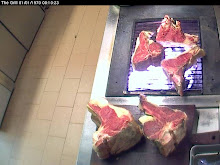

Buccellato is to Lucca what Panforte is to Siena and Panettone is to the Veneto region—a local tradition, especially for the holidays.
The first and most famous manufacturer of the "Buccellato Taddeucci" was founded way back in 1881 by Jacopo Taddeucci, who confectioned a sweet that was then to enter into the rich gastronomic culture of the province of Lucca. Even today, when talking about "buccellato" this is implicitly identified with the name Taddeucci. The Taddeucci family has since kept up this long and great tradition, continuing in the footsteps of the founder, and their commitment has brought the name of the buccellato to be known around the world.
Fashion the recipe into three smaller loaves for giving. Freezing the Buccellato works well for up to three months.
Makes 1 large loaf, serving 8 to 10
Anise and currants flavor this legendary bread of Lucca. Shaped in the form of a ring, this golden bread isn't quite like Italy's other yeasted sweet breads. Instead of being rich and cake-like, Buccellato is lightly sweetened and spiced—an appealing chewy white bread with a dense, lean crumb. I like Buccellato's simplicity. It tastes like homemade farmhouse bread spiffed up for company with currants and sugar. It's superb with any sweet wine.
In Lucca, no celebration happens without Buccellato and glasses of the sweet Vin Santo. When family comes from far away, Buccellato is served. At a christening for a new baby, Buccellato is served. Youngsters plead with parents, "Aunt Amelia is here (from across town), can't we have Buccellato?" But it's never just any Buccellato.
Serve Buccellato sliced thin with glasses of Vin Santo. Toast leftovers for breakfast, or an after-dinner treat with fruit.
Cook to Cook:
A heavy-duty electric mixer is handy here, as the dough is a dense one. Its beating bruises the currants, slightly darkening the dough but spreading their flavor through the bread. Certainly a wooden spoon will accomplish the same thing, but it takes much more elbow grease. Use an organic bread or high-protein flour if at all possible. Anticipate about 7-1/2 hours to make the bread. If more convenient, the first rise of 4 hours can be stretched to overnight in a cool place.
* 2-1/4 teaspoons (1 package) active dry yeast
* 2/3 cup warm water (90 F)
* About 5 cups (25 ounces unbleached white bread flour (preferably organic)
* 1-1/4 cups milk, at room temperature
* 1 tablespoon anise seeds, bruised with the side of a knife
* 2 teaspoons salt
* 3/4 cup (5.25 ounces) sugar
* 1 cup (about 1/4 pound) currants, soaked in hot water 15 minutes and drained
Glaze:
* 1 tablespoon sugar
* 1 tablespoon water
* 1 large egg
1. In the bowl of a heavy-duty mixer or another large bowl, dissolve the yeast in half the water, with a pinch of the flour. Let proof 10 minutes, or until bubbly. With the paddle attachment at low speed, or by hand, beat in the rest of the water, the milk, anise seeds, salt, sugar, and currants. Slowly beat in 4 cups of the flour until a soft dough has formed.
2. Replace the paddle with the dough hook and knead at medium-low speed 15 minutes, adding an additional cup of flour a tablespoon at a time, for a soft, sticky dough. Remove the dough to a floured work surface. Knead by hand 2 minutes to form a soft, very elastic dough that is barely sticky. Or, if working by hand, stir in flour until the dough is too heavy to handle. Turn it out onto a floured surface and knead in the remaining flour until the dough is soft, extremely elastic, and barely sticky. Place the dough in an oiled bowl. Cover with plastic wrap and let rise at room temperature 4 hours, or until almost tripled in bulk.
3. Oil a large cookie sheet or pizza pan. Knead down the dough. It will be sticky. Shape the dough into a 24-inch-long log. Bring the ends together, forming a ring, pinch ends to seal, and set it on the pan. Place an oiled upside-down custard cup or ramekin (about 3 inches in diameter) in the center to maintain the shape of the ring as the dough rises. Cover and let rise at room temperature 1-1/2 to 2 hours, until barely doubled.
4. Preheat the oven to 375 F. In a small bowl, beat together the glaze ingredients. Brush generously over the dough. Bake 50 to 55 minutes, or until the bread is a deep mahogany brown and sounds hollow when its bottom is thumped. Cool on a rack. Buccellato keeps several days at room temperature, if well wrapped.
Thanks to The Baker's Chronicle
















